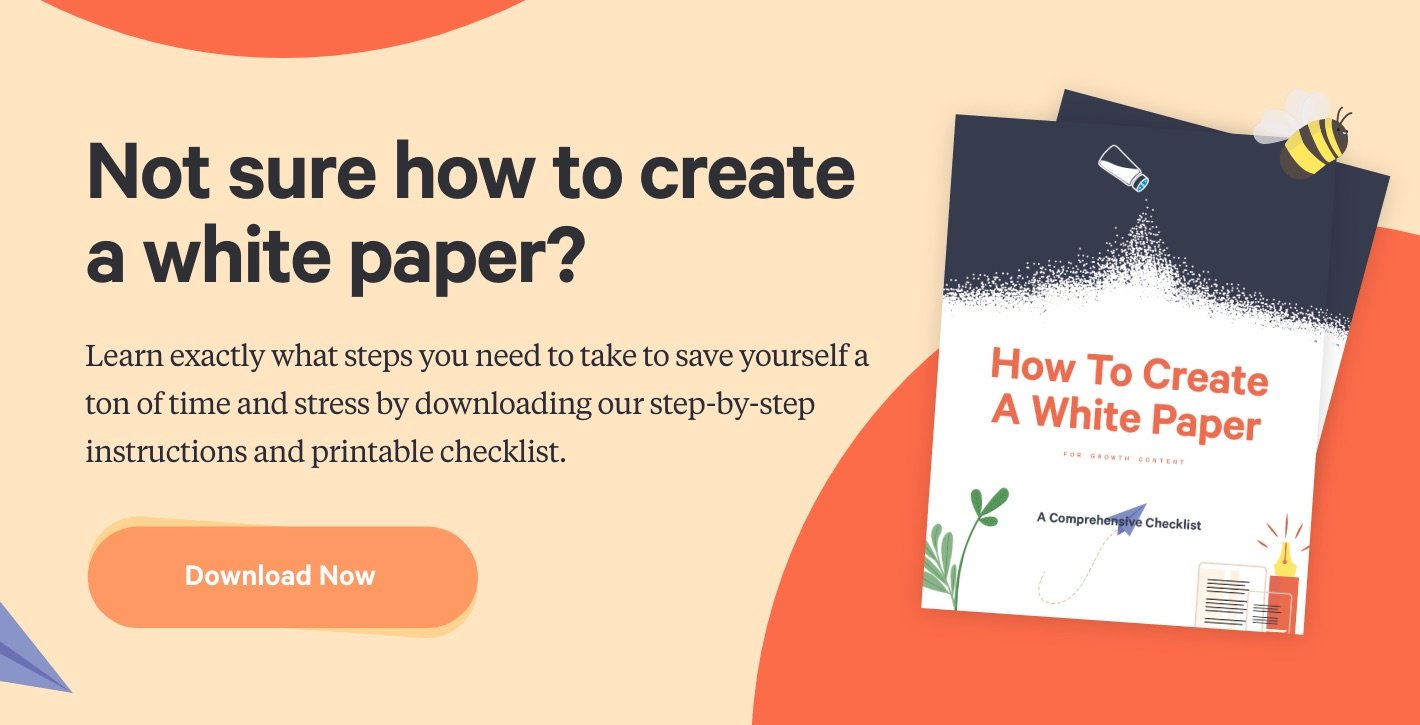The 5 W's Of A White Paper (White Paper Checklist Included)


by Tiffany Nix • 2 minute read • March 25, 2016

Need to write a white paper, but don't quite know where to get started?
Our free white paper checklist is exactly what you need. But before you skip down the page to find it, ask yourself, "Do I really know what a white paper is and why I'm writing one?"
In case you don't, let's address that: What exactly is a white paper?
I could spare you the smart aleck answer, but where's the fun in that? You know, "a sheet of material manufactured from the pulp of wood that typically measures 8½ x 11 inches..." (Hyuck.)
In all seriousness, though, when it comes to inbound marketing:
White papers are downloadable offers you provide for your potential customers that work 24/7 on your website in order to provide value for your prospects and provide new leads for you.
Let's break that down so it's a little easier to understand.
The 5 W's Of A White Paper
What: White papers are downloadable offers you provide...
How familiar are you with inbound marketing? (If you're a beginner, this guide is a good place to start.) One major piece of the inbound marketing process is to consistently create valuable content in the form of blog posts or articles about topics that your customers are asking about. You post that content on your website for potential customers to find (through organic search, social media shares, etc.). Then, within those articles or blog posts, you add something else valuable—more information on the topic the visitor just read about or knowledge on a topic that relates within your industry—something that a visitor can download for free (we call it an "offer"), as long as they fill out one or two pieces of information about themselves.
That download could be in the form of many things (like an on-demand webinar, an ebook, or a slideshow), but many times, it's in the form of a white paper.
I think Wikipedia defines it best: A white paper is "an authoritative report or guide helping readers to understand an issue, solve a problem, or make a decision." The goal of any white paper is to use data to educate your audience and convince them to agree with your perspective on an issue.
A white paper should reflect the voice of your company, but should also have a professional and educational tone. Remember, your goal is to inform and persuade your readers.
On average, white papers range anywhere from 6-12 pages, but can certainly be longer. As a general rule, you should make your white paper as long as it needs to be—meaning, write as much as you need to sufficiently inform your readers of everything they need to know. If you can do this in six pages, great. But, if you need 12-15 pages to do your topic justice, then write a longer white paper. (Just make sure all your pages are filled with good, solid information. No one wants to read “fluff”!)
Every white paper should have a cover, title page, introduction, and conclusion. If your white paper is longer and has many sections, it's wise to include a table of contents, too. Consider breaking up your text with graphs, images, charts, and other visual elements. This helps keep readers interested and gives them another way of learning the information you’re sharing. (Speaking of your readers...)
Who: ...for your potential customers...
A white paper is 100% for your website visitors—aka potential customers. Which means, when you go to write a white paper, it should be with them in mind!
Many business owners and marketers tend to want to write about how great their products and services are whenever they set out to write content. In other words, they want to talk about themselves. And that's only natural. However, your customers don't want to hear all about everything you can offer them. They want to find solutions for problems they're having in their day-to-day work, read tips about how to work better and smarter, and learn more about their industry in general.
So, when you're thinking of topics for white papers, think about your potential customers. What questions are they asking? What knowledge do you have about issues they face that could help them figure things out? Remember—it's all about providing content that is valuable to them.
When & Where: ...that work 24/7 on your website...
The great thing about a white paper is that, once it's set up on your site (on a landing page where potential customers can fill out a form in exchange for the download), it works for you 24/7. I've heard it explained like this: It's an employee that never sleeps! It's working for you all day, everyday, getting you insightful information about potential new customers. What could be better than that?
Why: ...in order to provide value for your prospects and provide new leads for you.
The benefits of white papers, especially as a part of an overall inbound marketing strategy, are huge.
When you give away knowledge and insight about your industry for free, you're giving value to your current customers, and in turn, are building their trust.
When you give that same knowledge, insight, and value to potential customers for free, you're earning trust, and even more importantly, you're gathering bits and pieces of information about them that you wouldn't have otherwise.
No matter how you slice and dice it, it's a giant win.
Our Free White Paper Checklist
Now that you've learned the five W's of a white paper, download our free white paper checklist to get started on your own!
I'm curious—how are you planning on using a white paper (or our white paper checklist) for your business? Let me know in a comment below!
